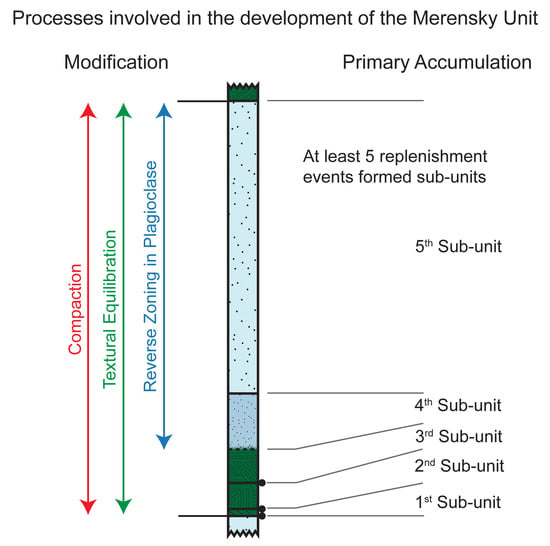The Merensky Cyclic Unit, Bushveld Complex, South Africa: Reality or Myth?
Abstract
:1. Introduction
1.1. The Bushveld Complex
1.2. The Merensky Unit
Theories for the Development of the Merensky Unit
2. Methods
2.1. Element Mapping
2.2. Crystal Size Distribution Analysis
2.2.1. Crystal Size Distribution Theory
2.2.2. Crystal Size Distribution Methods
3. Results
3.1. Field Characteristics of the Merensky Unit
3.2. Petrographic Characteristics of the Merensky Unit
3.3. Element Maps
3.4. Crystal Size Distributions Results
4. Discussion
4.1. Development of the Merensky Unit
4.1.1. Evaluation of the Role of Gravitational Settling
4.1.2. Evaluation of the Role of Magmatic Flow and/or Crystal Slurries
4.1.3. Evaluation of the Role of Intrusion
4.1.4. Evaluation of the Role of In Situ Crystallisation
4.2. Modification of Primary Textures within the Merensky Unit
4.2.1. Textural Modification through Equilibration
4.2.2. Chemical Modification
4.2.3. Textural Modification through Compaction
4.3. Model for Development of the Merensky Unit
5. Conclusions
Supplementary Materials
Acknowledgments
Author Contributions
Conflicts of Interest
References
- Cawthorn, R.G. The Bushveld Complex, South Africa. In Layered Intrusions; Charlier, B., Namur, O., Latypov, R., Tegner, C., Eds.; Springer Geology: Dordrecht, The Netherlands, 2015; pp. 649–691. [Google Scholar]
- Namur, O.; Abily, B.; Boudreau, A.E.; Blanchette, F.; Bush, J.W.M.; Ceuleneer, G.; Charlier, B.; Donaldson, C.H.; Duchesne, J.-C.; Higgins, M.D.; et al. Igneous Layering in Basaltic Magma Chambers. In Layered Intrusions; Charlier, B., Namur, O., Latypov, R., Tegner, C., Eds.; Springer Geology: Dordrecht, The Netherlands, 2015; pp. 75–152. [Google Scholar]
- Mungall, J.E.; Kamo, S.L.; McQuade, S. U-Pb geochronology documents out-of-sequence emplacement of ultramafic layers in the Bushveld Igneous Complex of South Africa. Nat. Commun. 2016, 7, 13385. [Google Scholar] [CrossRef] [PubMed]
- Scoates, J.S.; Wall, C.J. Geochronology of Layered Intrusions. In Layered Intrusions; Charlier, B., Namur, O., Latypov, R., Tegner, C., Eds.; Springer Geology: Dordrecht, The Netherlands, 2015. [Google Scholar]
- Holness, M.B.; Vukmanovic, Z.; Mariani, E. Assessing the Role of Compaction in the Formation of Adcumulates: A Microstructural Perspective. J. Petrol. 2017, 58, 643–673. [Google Scholar] [CrossRef]
- Latypov, R.; Chistyakova, S.; Barnes, S.J.; Hunt, E.J. Origin of Platinum Deposits in Layered Intrusions by In Situ Crystallization: Evidence from Undercutting Merensky Reef of the Bushveld Complex. J. Petrol. 2017, 58, 715–761. [Google Scholar] [CrossRef]
- Latypov, R.; Chistyakova, S.; Page, A.; Hornsey, R. The Merensky Reef of the Bushveld Complex: Origin by In Situ Crystallization from a Basal Layer of Magma. J. Petrol. 2015, 56, 2341–2372. [Google Scholar] [CrossRef]
- Brynard, H.J.; De Villiers, J.P.R.; Viljoen, E.A. A Mineralogical Investigation of the Merensky Reef at the Western Platinum Mine, near Marikana, South Africa. Econ. Geol. 1976, 71, 1299–1307. [Google Scholar] [CrossRef]
- Vermaak, C.F. The Merensky Reef—Thoughts on its Environment and Genesis. Econ. Geol. 1976, 71, 1270–1298. [Google Scholar] [CrossRef]
- Kruger, F.J. The Merensky and Bastard cyclic units and the Platreef of the Bushveld Complex: Consequences of Main Zone magma influxes and dynamics. In Proceedings of the 4th International Platinum Conference, Platinum in Transition “Boom or Bust“, Sun City, North West, South Africa, 11–14 October 2010; Southern African Institute of Mining and Metallurgy: Johannesburg, South Africa, 2010; pp. 43–46. [Google Scholar]
- Nicholson, D.M.; Mathez, E.A. Petrogenesis of the Merensky Reef in the Rustenberg section of the Bushveld Complex. Contrib. Mineral. Petrol. 1991, 107, 293–309. [Google Scholar] [CrossRef]
- Lee, C.A.; Butcher, A.R. Cyclicity in the Sr isotope stratigraphy through the Merensky and Bastard Reef units, Atok section, Eastern Bushveld Complex. Econ. Geol. 1990, 85, 877–883. [Google Scholar] [CrossRef]
- Webb, S.J.; Cawthorn, R.G.; Nguuri, T.; James, D. Gravity modeling of Bushveld Complex connectivity supported by Southern African Seismic Experiment results. S. Afr. J. Geol. 2004, 107, 207–218. [Google Scholar] [CrossRef]
- Lonmin Platinum. Mineral Resource and Mineral Reserve Statement; Lonmin: Johannesburg, South Africa, 2016; p. 43. [Google Scholar]
- Eales, H.V.; Costin, G. Custally Contaminated Komatiite: Primary Source of the Chromitites and Marginal, Lower and Critical Zone Magmas in a Staging Chamber Beneath the Bushveld Complex. Econ. Geol. 2012, 107, 645–665. [Google Scholar] [CrossRef]
- Cawthorn, R.G. The platinum and palladium resources of the Bushveld Complex. S. Afr. J. Sci. 1999, 95, 481–489. [Google Scholar]
- Boudreau, A.E.; Kruger, F.J. Variation in the Composition of Apatite through the Merensky Cyclic Unit in the Western Busvheld Complex. Econ. Geol. 1990, 85, 737–745. [Google Scholar] [CrossRef]
- Roberts, M.D.; Reid, D.L.; Miller, J.A.; Basson, I.J.; Roberts, M.; Smith, D. The Merensky Cyclic Unit and its impact on footwall cumulates below Normal and Regional Pothole reef types in the Western Bushveld Complex. Mineralium Deposita 2007, 42, 271–292. [Google Scholar] [CrossRef]
- Cawthorn, R.G.; Spies, L. Plagioclase content of cyclic units in the Bushveld Complex, South Africa. Contrib. Mineral. Petrol. 2003, 145, 47–60. [Google Scholar] [CrossRef]
- Jackson, E.D. The Cyclic Unit in Layered Intrusions—A Comparison of Repetitive Stratigraphy in the Ultramafic Parts of the Stillwater, Muskox, Great Dyke, and Bushveld Complexes; Geological Society of South Africa Special Publications: Johannesburg, South Africa, 1970; Volume 1. [Google Scholar]
- Kruger, F.J. The origin of the Merensky cyclic unit: Sr-isotopic and mineralogical evidence for an alternative orthomagmatic model. Aust. J. Earth Sci. 1992, 39, 255–261. [Google Scholar] [CrossRef]
- Kruger, F.J.; Marsh, J.S. The Mineralogy, Petrology, and Origin of the Merensky Cyclic Unit in the Western Bushveld Complex. Econ. Geol. 1985, 80, 958–974. [Google Scholar] [CrossRef]
- Naldrett, A.J.; Wilson, A.; Kinnaird, J.; Chunnett, G. PGE tenor and metal ratios within and below the Merensky Reef, Busvheld Complex: Implications for its genesis. J. Petrol. 2009, 50, 625–659. [Google Scholar] [CrossRef]
- Scoon, R.N.; Teigler, B. Platinum-group mineralisation in the critical zone of the western Bushveld Complex; I, Sulphide poor-chromitites below the UG-2. Econ. Geol. 1994, 89, 1094–1121. [Google Scholar] [CrossRef]
- Irvine, T.N. Terminology for Layered Intrusions. J. Petrol. 1982, 23, 127–162. [Google Scholar] [CrossRef]
- Irvine, T.N. Processes involved in the formation and development of layered igneous rocks. In Origins of Igneous Layering; Parsons, I., Ed.; D. Reidel Publishing: Dordrecht, The Netherlands, 1987; Volume 196, pp. 649–656. [Google Scholar]
- Mitchell, A.A.; Scoon, R.N. The Merensky Reef at Winnaarshoek, Eastern Bushveld Complex: A primary magmatic hypothesis based on a wide reef facies. Econ. Geol. 2007, 102, 971–1009. [Google Scholar] [CrossRef]
- Naldrett, A.J. Stratiform PGE Deposits in layered intrusions. In Ore Deposition Associated with Magmas. Reviews in Economic Geology; Whitney, J.A., Naldrett, A.J., Eds.; Springer: Dordrecht, The Netherlands, 1989; pp. 135–166. [Google Scholar]
- Viljoen, M.J. The nature and origin of the Merensky Reef of the western Bushveld Complex based on geological facies and geophysical data. S. Afr. J. Geol. 1999, 102, 221–239. [Google Scholar]
- Campbell, I.H.; Naldrett, A.J.; Barnes, S.J. A model for the origin of platinum-rich sulphide horizons in the Bushveld and Stillwater complexes. J. Petrol. 1983, 24, 133–165. [Google Scholar] [CrossRef]
- Eales, H.V. Caveats in defining the magmas parental to the mafic rocks of the Bushveld Complex, and the manner of their emplacement: Review and commentary. Mineral. Mag. 2002, 66, 815–832. [Google Scholar] [CrossRef]
- Hutchinson, D.; Foster, J.; Prichard, H.; Gilbert, S. Concentration of Particulate Platinum-Group Minerals during Magma Emplacement; a Case Study from the Merensky Reef, Bushveld Complex. J. Petrol. 2015, 56, 113–159. [Google Scholar] [CrossRef]
- Maier, W.D.; Bowen, M.P. The UG2-Merensky Reef interval of the Bushveld Complex northwest of Pretoria. Miner. Depos. 1996, 31, 386–393. [Google Scholar]
- Lee, C.A. A Review of Mineralization in the Bushveld Complex and some other Layered Intrusions. In Layered Intrusions; Cawthorn, R.G., Ed.; Elsevier Science: Amsterdam, The Netherlands, 1996; Volume 15, pp. 103–145. [Google Scholar]
- Naldrett, A.J.; Kinnaird, J.; Wilson, A.; Yudoskaya, M.; McQuade, S.; Chunnett, G.; Stanley, C. Chromitite composition and PGE content of the Bushveld chromitites: Part 1—The Lower and Middle Groups. Appl. Earth Sci. 2009, 118, 131–161. [Google Scholar] [CrossRef]
- Walraven, F. Geochronology of the Rooiberg Group, Transvaal Supergroup, South Africa; Economic Geology Research Unit, University of the Witwatersrand: Johannesburg, South Africa, 1997; Volume 316. [Google Scholar]
- Zeh, A.; Ovtcharova, M.; Wilson, A.H.; Schaltegger, U. The Busvheld Complex was emplaced and cooled in less than one million years—Results of zirconology, and geotectonic implications. Earth Planet. Sci. Lett. 2015, 418, 103–114. [Google Scholar] [CrossRef]
- Walraven, F.; Hattingh, E. Geochronology of the Nebo Granite, Bushveld Complex. S. Afr. J. Geol. 1993, 96, 31–41. [Google Scholar]
- SACS. Stratigraphy of South Africa Handbook 8. Part 1: Lithostratigraphy of the Republic of South Africa, South West Africa/Namibia and the Republics of Bophuthatswana, Transkei and Venda, 1st ed.; Government Printer: Pretoria, South Africa, 1980; Volume 8.
- Cawthorn, R.G. The Platinum Group Element Deposits of the Bushveld Complex in South Africa. Platin. Met. Rev. 2010, 54, 205–215. [Google Scholar] [CrossRef]
- Cawthorn, R.G.; Boerst, K. Origin of the Pegmatitic Pyroxenite in the Merensky Unit, Bushveld Complex, South Africa. J. Petrol. 2006, 47, 1509–1530. [Google Scholar] [CrossRef]
- Le Maitre, R.W. Igneous Rocks A Classification and Glossary of Terms, 2nd ed.; Cambridge University Press: Cambridge, UK, 2002. [Google Scholar]
- Hunter, D. The Bushveld Complex and its Remarkable Rocks. Am. Sci. 1978, 66, 551–559. [Google Scholar]
- Ferguson, J.; Botha, E. Some aspects of igneous layering in the basic zones of the Bushveld Complex. Trans. Geol. Soc. S. Afr. 1963, 66, 259–278. [Google Scholar]
- Maier, W.D.; Barnes, S.-J.; Groves, D.I. The Bushveld Complex, South Africa: Formation of platinum–palladium, chrome- and vanadium-rich layers via hydrodynamic sorting of a mobilized cumulate slurry in a large, relatively slowly cooling, subsiding magma chamber. Miner. Depos. 2013, 48, 1–56. [Google Scholar] [CrossRef]
- Forien, M.; Tremblay, J.; Barnes, S.-J.; Burgisser, A.; Pagé, P. The role of viscous particle segregation in forming chromite layers from slumped crystal slurries: Insights from analogue experiements. J. Petrol. 2015, 56, 2425–2444. [Google Scholar] [CrossRef]
- Boudreau, A.E. Modeling the Merensky Reef, Busvheld Complex, Republic of South Africa. Contrib. Mineral. Petrol. 2008, 156, 431–437. [Google Scholar] [CrossRef]
- Campbell, I.H. Some problems with the cumulus theory. Lithos 1978, 11, 311–323. [Google Scholar] [CrossRef]
- Jackson, E.D. Primary Textures and Mineral Associations in the Ultramafic Zone of the Stillwater Complex, Montana; US Geological Survey: Washington, DC, USA, 1961. [Google Scholar]
- Langmuir, C.H. Geochemical consequences of in situ crystallization. Nature 1989, 340, 199–205. [Google Scholar] [CrossRef]
- Martin, D. Crystal settling and in situ crystallization in aqueous solutions and magma chambers. Earth Planet. Sci. Lett. 1990, 96, 336–348. [Google Scholar] [CrossRef]
- McBirney, A.R.; Noyes, R.M. Crystallization and layering of the Skaergaard Intrusion. J. Petrol. 1979, 20, 487–554. [Google Scholar] [CrossRef]
- Campbell, I.H. Fluid Dynamic Processes in Basaltic Magma Chambers. In Layered Intrusions: Developments in Petrology; Cawthorn, R.G., Ed.; Elsevier Science, B.V.: Amsterdam, The Netherlands, 1996; pp. 45–76. [Google Scholar]
- Hunter, R.H. Texture development in cumulate rocks. In Layered Intrusions; Cawthorn, R.G., Ed.; Elsevier Science, B.V.: Amsterdam, The Netherlands, 1996; Volume 15, pp. 77–101. [Google Scholar]
- Voordouw, R.; Gutzmer, J.; Beukes, N.J. Intrusive origin for Upper Group (UG1, UG2) stratifrom chromitite seams in the Dwars River area, Busvheld Complex, South Africa. Mineral. Petrol. 2009, 97, 75–94. [Google Scholar] [CrossRef]
- Higgins, M.D. Imaging birefringent minerals without extinction using circularly polarized light. Can. Mineral. 2010, 48, 231–235. [Google Scholar] [CrossRef]
- Marsh, B.D. Crystal size distribution (CSD) in rocks and the kinetics and dynamics of crystallization I. Theory. Contrib. Mineral. Petrol. 1988, 99, 277–291. [Google Scholar] [CrossRef]
- Higgins, M.D. Quantitative Textural Measurements in Igneous & Metamorphic Petrology; Cambridge University Press: Cambridge, UK, 2006; p. 265. [Google Scholar]
- Cashman, K.V.; Marsh, B.D. Crystal size distribution (CSD) in rocks and the kinetics and dynamics of crystallization II: Makaopuhi lava lake. Contrib. Mineral. Petrol. 1988, 99, 292–305. [Google Scholar] [CrossRef]
- Marsh, B.D. On the interpretation of crystal size distributions in magmatic systems. J. Petrol. 1998, 39, 553–599. [Google Scholar] [CrossRef]
- Vernon, R.H. A Practical Guide to rock Microstructure; Cambridge University Press: Cambridge, UK, 2004; p. 594. [Google Scholar]
- Boorman, S.; Boudreau, A.; Kruger, F.J. The Lower Zone-Critical Zone Transition of the Bushveld Complex: A Quantitative Textural Study. J. Petrol. 2004, 45, 1209–1235. [Google Scholar] [CrossRef]
- Higgins, M.D. Textural coarsening in igneous rocks. Int. Geol. Rev. 2011, 53, 354–376. [Google Scholar] [CrossRef]
- Holness, M.B.; Vernon, R.H. The Influence of Interfacial Energies on Igneous Microstructures. In Layered Intrusions; Charlier, B., Namur, O., Latypov, R., Tegner, C., Eds.; Springer Geology: Dordrecht, The Netherlands, 2015. [Google Scholar]
- Hunter, R.H. Textural Equilibrium in Layered Igneous Rocks. In Origins of Igneous Layering; Parsons, I., Ed.; D. Reidel Publishing: Dordrecht, The Netherlands, 1987; Volume 196, pp. 473–503. [Google Scholar]
- Toramaru, A.; Matsumoto, M. Numerical experiment of cyclic layering in a solidified binary eutectic melt. J. Geophys. Res. 2012, 117, B02209. [Google Scholar] [CrossRef]
- Higgins, M.D. Measurement of crystal size distributions. Am. Mineral. 2000, 85, 1105–1116. [Google Scholar] [CrossRef]
- Waters, C.; Boudreau, A.E. A reevaluation of crystal-size distributions in chromite cumulates. Am. Mineral. 1996, 81, 1452–1459. [Google Scholar] [CrossRef]
- Cabane, H.; Laporte, D.; Provost, A. Experimental investigation of the kinetics of Ostwald ripening of quartz in silicic melts. Contrib. Mineral. Petrol. 2001, 142, 361–373. [Google Scholar] [CrossRef]
- Cabane, H.; Laporte, D.; Provost, A. An experimental study of Ostwald ripening of olivine and plagioclase in silicate melts: Implications for the growth and size of crystals in magmas. Contrib. Mineral. Petrol. 2005, 150, 37–53. [Google Scholar] [CrossRef]
- DeHoff, R.T. A geometrically general theory of diffusion controlled coarsening. Acta Metall. Mater. 1991, 39, 2349–2360. [Google Scholar] [CrossRef]
- Higgins, M.D. Origin of Anorthosite by Textural Coarsening: Quantitative Measurements of a Natural Sequence of Textural Development. J. Petrol. 1998, 39, 1307–1323. [Google Scholar] [CrossRef]
- Simakin, A.G.; Bindeman, I.N. Evolution of crystal sizes in the series of dissolution and precipitation events in open magma systems. J. Volcanol. Geotherm. Res. 2008, 177, 997–1010. [Google Scholar] [CrossRef]
- Schneider, C.A.; Rasband, W.S.; Eliceiri, K.W. NIH Image to ImageJ: 25 years of image analysis. Nat. Methods 2012, 9, 671–675. [Google Scholar] [CrossRef] [PubMed]
- Morgan, D.J.; Jerram, D.A. On estimating crystal shape for crystal size distribution analysis. J. Volcanol. Geotherm. Res. 2006, 154, 1–7. [Google Scholar] [CrossRef]
- Mock, A.; Jerram, D.A. Crystal Size Distribution (CSD) in Three Dimensions: Insights from the 3D Reconstruction of a Highly Porphyritic Rhyolite. J. Petrol. 2005, 46, 1525–1541. [Google Scholar] [CrossRef]
- Higgins, M.D. Origin of megacrysts in granitoids by textural coarsening: A crystal size distribution (CSD) study of microcline in the Cathedral Peak Granodiorite, Sierra Nevada, California. In Understanding Granites: Integrating New and Classical Techniques; Castro, A., Fernández, C., Vigneresse, J.L., Eds.; Geological Society London, Special Publications: London, UK, 1999; Volume 168, pp. 207–219. [Google Scholar]
- Smith, D.S.; Basson, I.J.; Reid, D.L. Normal Reef Subfacies of the Merensky Reef at Northam Platinum Mine, Zwartklip Facies, Western Bushveld Complex, South Africa. Can. Mineral. 2003, 42, 243–260. [Google Scholar] [CrossRef]
- Wagner, P.A. The Platinum Deposits and Mines of South Africa; Oliver & Boyd: Edinburgh, UK, 1929; p. 326. [Google Scholar]
- Wilson, A.H.; Lee, C.A.; Brown, R.T. Geochemistry of the Merensky Reef, Rustenburg section, Bushveld Complex: Controls on the silicate framework and distribution of trace elements. Miner. Depos. 1999, 34, 657–672. [Google Scholar] [CrossRef]
- Barnes, S.-J.; Maier, W. Platinum-group elements and microstructures from Impala Platinum Mines, Bushveld Complex. J. Petrol. 2002, 43, 103–128. [Google Scholar] [CrossRef]
- Higgins, M.D. Closure in crystal size distributions (CSD), verification of CSD calculations, and the significance of CSD fans. Am. Mineral. 2002, 87, 171–175. [Google Scholar] [CrossRef]
- Brown, R.; Retired, Mpumulanga, South Africa. Personal communication, 2017.
- Arndt, N.; Jenner, G.; Ohnenstetter, M.; Deloule, E.; Wilson, A.H. Trace elements in the Merensky Reef and adjacent norites Bushveld Complex South Africa. Miner. Depos. 2005, 40, 550–575. [Google Scholar] [CrossRef]
- Brothers, R.N. Petrofabric analyses of Rhum and Skaergaard layered rocks. J. Petrol. 1964, 5, 255–274. [Google Scholar] [CrossRef]
- Maier, W.; Barnes, S.-J. Platinum-group elements in the UG1 and UG2 chromitites, and the Bastard reef, at Impala platinum mine, western Bushveld Complex, South Africa: Evidence for late magmatic cumulate instability and reef constitution. S. Afr. J. Geol. 2008, 111, 159–176. [Google Scholar] [CrossRef]
- Williams, E.; Boudreau, A.E.; Boorman, S.; Kruger, F.J. Textures of orthopyroxenites from the Burgersfort bulge of the eastern Bushveld Complex, Republic of South Africa. Contrib. Mineral. Petrol. 2006, 151, 480. [Google Scholar] [CrossRef]
- Holness, M.B.; University of Cambridge, Cambridge, UK. Personal communication, 2017.
- Ildefonse, B.; Launeau, P.; Bouchez, J.-L. Effect of mechanical interactions on the development of shape preferred orientations: A two-dimensional experimental approach. J. Struct. Geol. 1992, 14, 73–83. [Google Scholar] [CrossRef]
- Ildefonse, B.; Arbaret, L.; Diot, H. Rigid particles in simple shear flow: Is their preferred orientation periodic or steady-state? In Granite: From Segregation of Melt to Emplacement Fabrics; Bouchez, J.-L., Hutton, D.W., Stephens, W.E., Eds.; Kluwer Academic Publishers: Dordrecht, The Netherlands, 1997; pp. 177–185. [Google Scholar]
- Davies, I.C.; Walker, R.G. Transport and deposition of resedimented conglomerates: The Cap Enrage Formation, Cambro-Ordovician, Gaspé, Quebec. J. Sediment. Petrol. 1974, 44, 1200–1216. [Google Scholar]
- Rust, B.R. Pebble orientation in fluvial sediments. J. Sediment. Petrol. 1972, 42, 384–388. [Google Scholar]
- Wall, C.J.; Scoates, J.S.; Weis, D.; Friedman, R.M.; Amini, M.; Meurer, W.P. The Stillwater Complex: Integrating Zircon Geochronological and Geochemical Constraints on the Age, Emplacement History and Crystallization of a Large, Open-System Layered Intrusion. J. Petrol. 2018, accepted. [Google Scholar] [CrossRef]
- Boudreau, A.E. Mineral segregation during crystal aging in two-crystal, two-component systems. S. Afr. J. Geol. 1994, 97, 473–485. [Google Scholar]
- Boudreau, A.E. Crystal aging and the formation of fine-scale igneous layering. Mineral. Petrol. 1995, 54, 55–69. [Google Scholar] [CrossRef]
- Emmerich, H.; Virnau, P.; Wilde, G.; Spatschek, R. Heterogeneous nucleation and microstructure formation: Steps towards a system and scale bridging understanding. Eur. Phys. J. Spec. Top. 2014, 223, 337–346. [Google Scholar] [CrossRef]
- Vukmanovic, Z.; Barnes, S.J.; Reddy, S.M.; Godel, B.; Fiorentini, M.L. Morphology and microstructure of chromite crystals in chromitites from the Merensky Reef (Bushveld Complex, South Africa). Contrib. Mineral. Petrol. 2013, 165, 1031–1050. [Google Scholar] [CrossRef]
- Hulbert, L.J.; Von Gruenewaldt, G. Textural and Compositional Features of Chromite in the Lower and Critical Zones of the Bushveld Complex South of Potgietersrus. Econ. Geol. 1985, 80, 872–895. [Google Scholar] [CrossRef]
- Li, C.; Ripley, E.M.; Sarkar, A.; Shin, D.; Maier, W.D. Origin of phlogopite-orthopyroxene inclusions in chromites from the Merensky Reef of the Bushveld Complex, South Africa. Contrib. Mineral. Petrol. 2005, 150, 119–130. [Google Scholar] [CrossRef]
- Roelofse, F.; Ashwal, L.D.; Pineda-Vargas, C.A.; Pryzbylowicz, W.J. Enigmatic textures developed along plagioclase-augite grain boundaries at the base of the Main Zone, Northern Limb, Bushveld Complex—Evidence for late stage melt infiltration into a nearly solidified crystal mush. S. Afr. J. Geol. 2009, 112, 39–46. [Google Scholar] [CrossRef]
- Hayes, B.; Ashwal, L.D.; Webb, S.J.; Bybee, G.M. Large-scale magmatic layering in the Main Zone of the Bushveld Complex and episodic downward magma infiltration. Contrib. Mineral. Petrol. 2017, 172, 13. [Google Scholar] [CrossRef]
- Passchier, C.W.; Trouw, R.A.J. Microtectonics, 2nd ed.; Springer: Berlin/Heidelberg, Germany, 2005. [Google Scholar]
- Alexandre, P.; Andreoli, M.A.G.; Jamison, A.; Gibson, R.L. 40Ar/39Ar age constraints on low-grade metamorphism and cleavage development in the Transvaal Supergroup (central Kaapvaal craton, South Africa): Implications for the tectonic setting of the Bushveld Igneous Complex. S. Afr. J. Geol. 2006, 109, 393–410. [Google Scholar] [CrossRef]
- Reimold, W.U.; Wittek, A.; Jourdan, F. Comment on 40Ar/39Ar age constraints on low-grade metamorphism and cleavage development in the Transvaal Supergroup (central Kaapvaal craton, South Africa): Implications for the tectonic setting of the Bushveld Igneous Complex (South African Journal of Geology, 109, 393–410), by Alexandre et al. (2006). S. Afr. J. Geol. 2007, 110, 157–159. [Google Scholar]
- Buthelezi, M.; Ashwal, L.D.; Horváth, P. Application of titanium-in-quartz geothermometry to magmatic quartz in evolved rocks from the Bushveld Complex, South Africa. S. Afr. J. Geol. 2017, 120.2, 241–250. [Google Scholar]
- Campbell, I.H. Distribution of Orthocumulate Textures in the Jimberlana Intrusion. J. Geol. 1987, 95, 35–53. [Google Scholar] [CrossRef]
- Latypov, R.; Costin, G.; Chistyakova, S.; Hunt, E.J.; Mukherjee, R.; Naldrett, T. Platinum-bearing chromite layers are caused by pressure reduction during magma ascent. Nat. Commun. 2018, 9, 462. [Google Scholar] [CrossRef] [PubMed]
- Barnes, S.J.; Robertson, J.C. Time scales and length scales in magma flow pathways and the origin of magmatic Ni-Cu-PGE ore deposits. Geosci. Front. 2018, in press. [Google Scholar]
- Carr, H.W.; Groves, D.I.; Cawthorne, R.G. The Importance of Synmagmatic Deformation in the Formation of Merensky Reef Potholes in the Bushveld Complex. Econ. Geol. 1994, 89, 1398–1410. [Google Scholar] [CrossRef]
- Carr, H.W.; Kruger, F.J.; Groves, D.I.; Cawthorn, R.G. The petrogenesis of Merenksy Reef potholes at the Western Platinum Mine, Bushveld Complex: Sr-istopic evidence for synmagmatic deformation. Minera. Depos. 1999, 34, 335–347. [Google Scholar] [CrossRef]
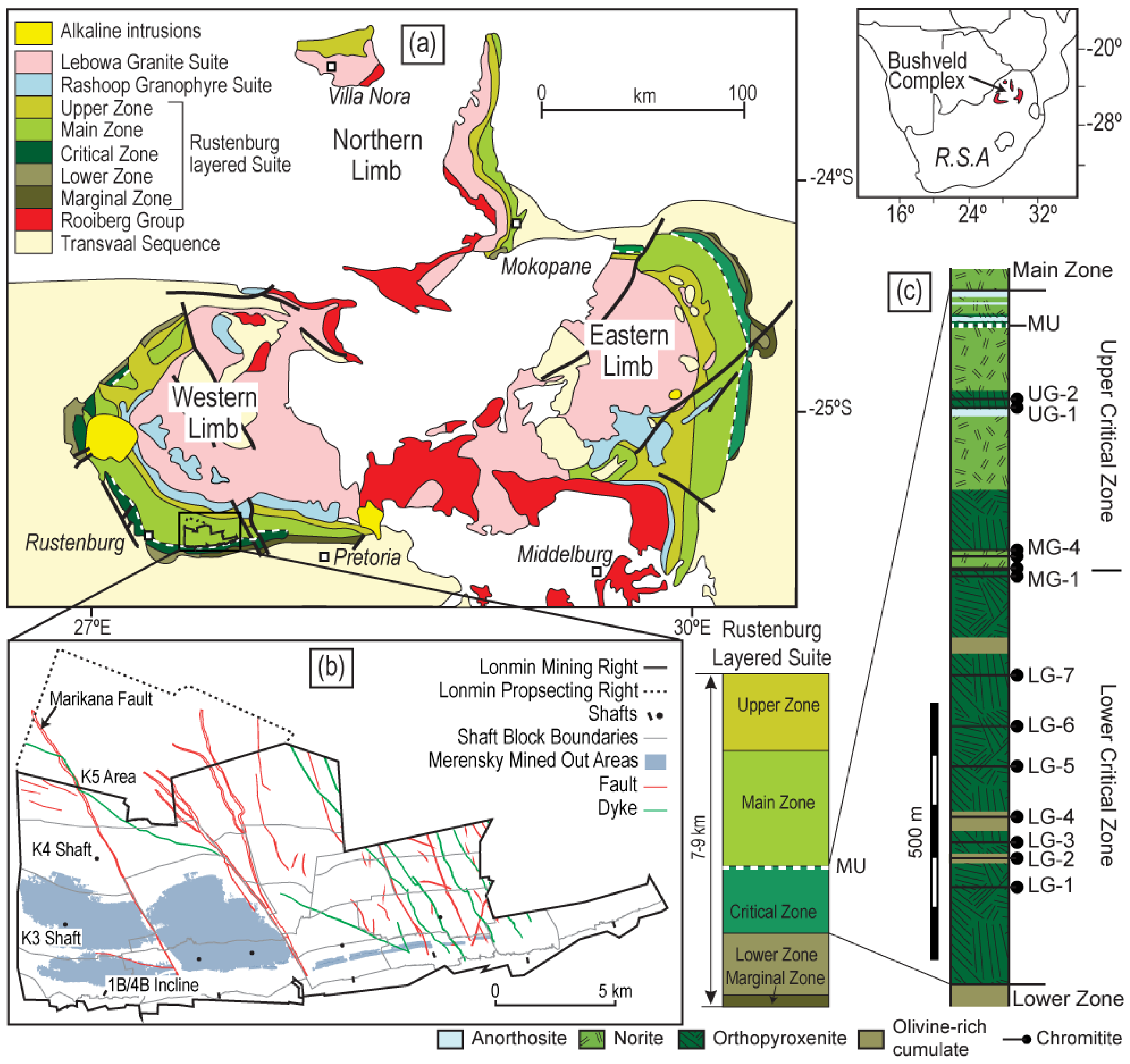


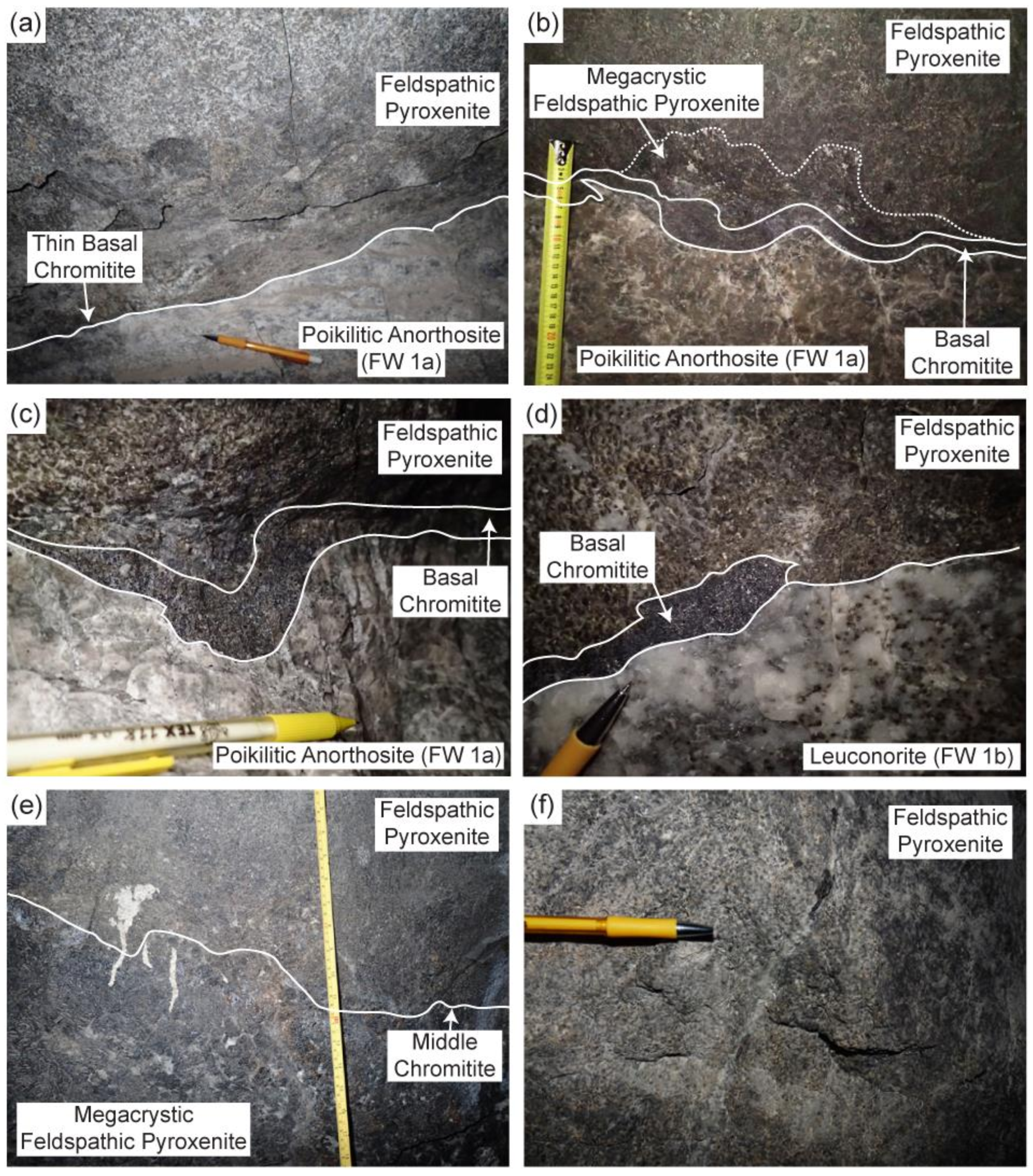


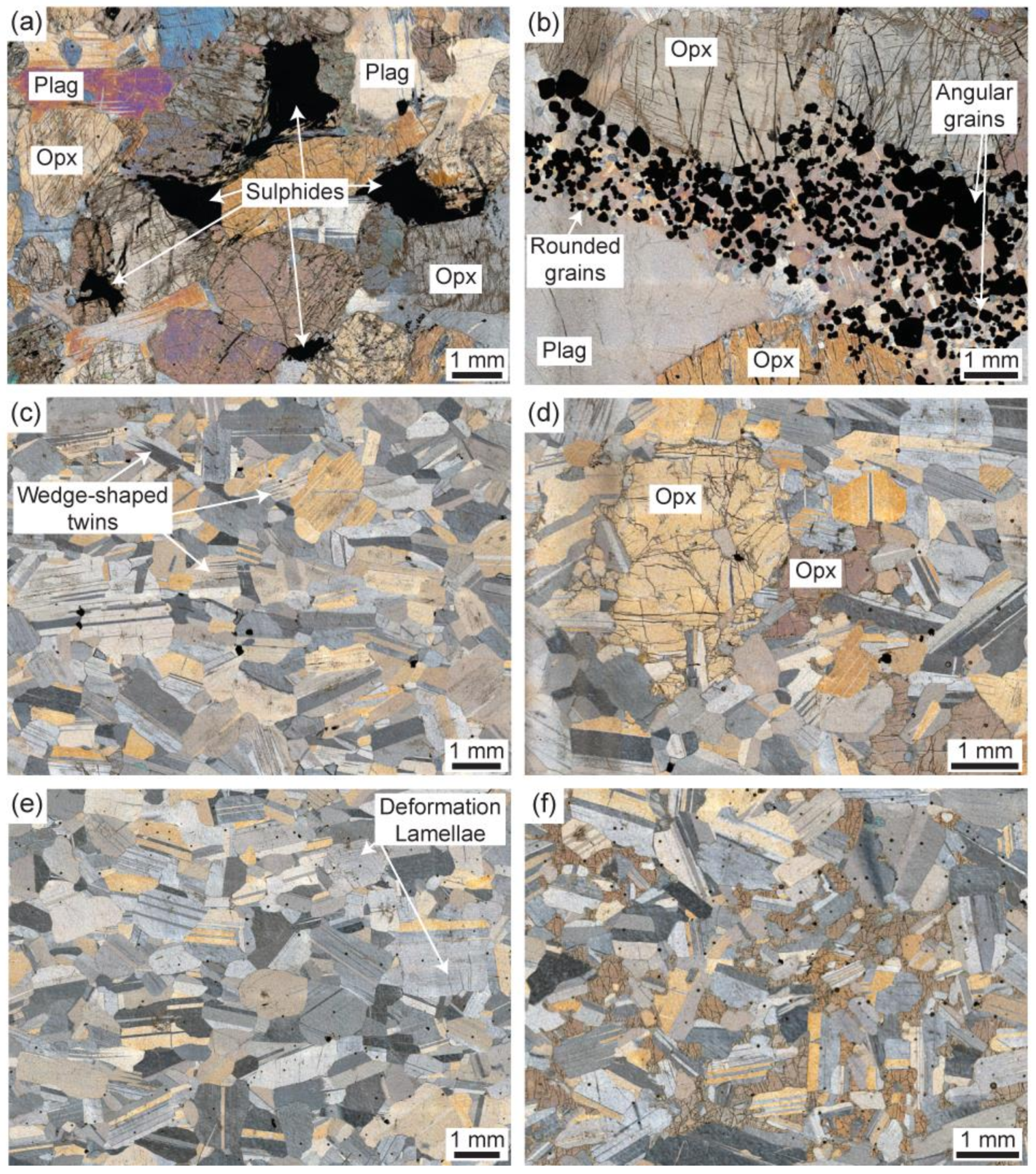
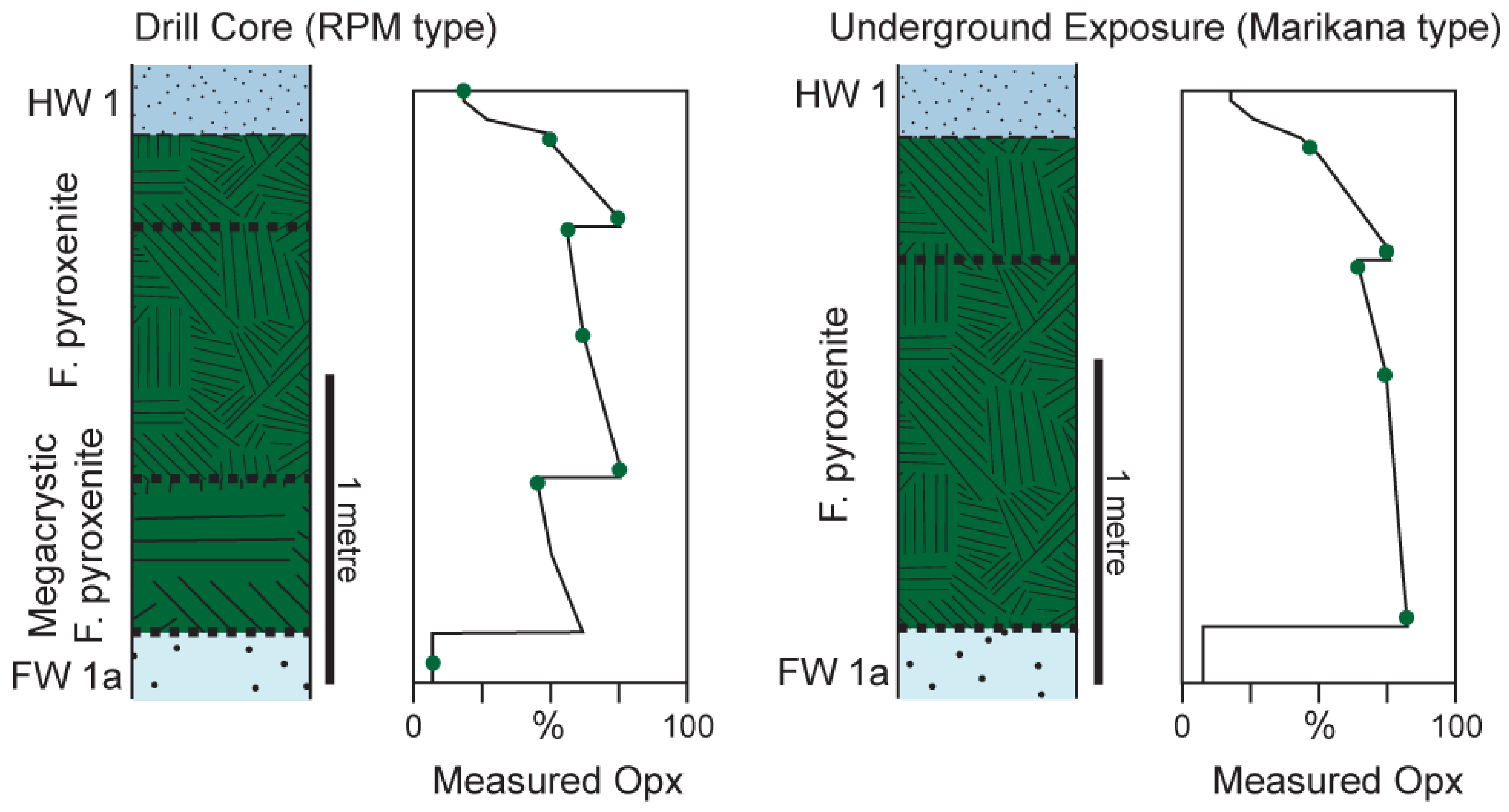
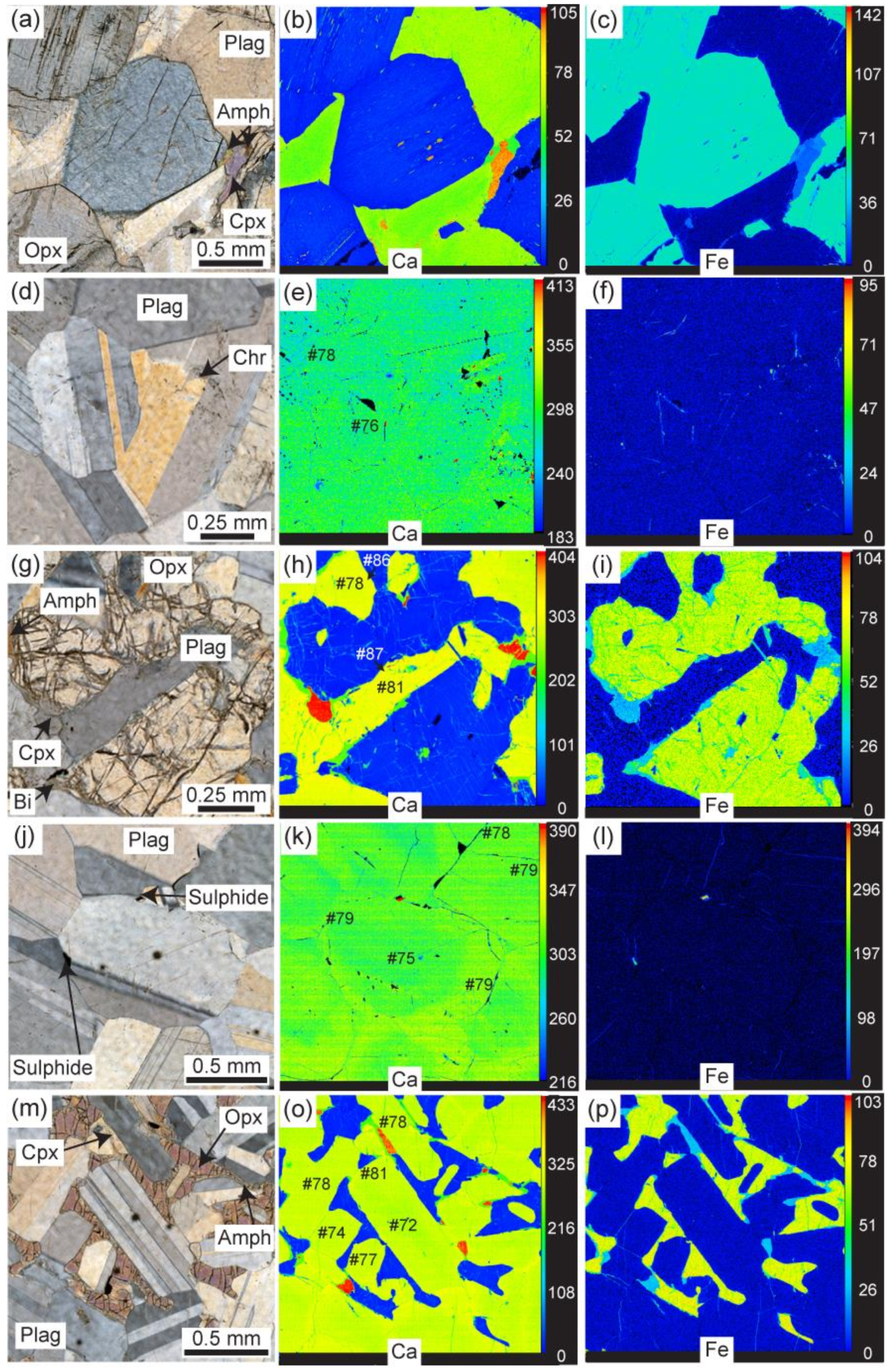
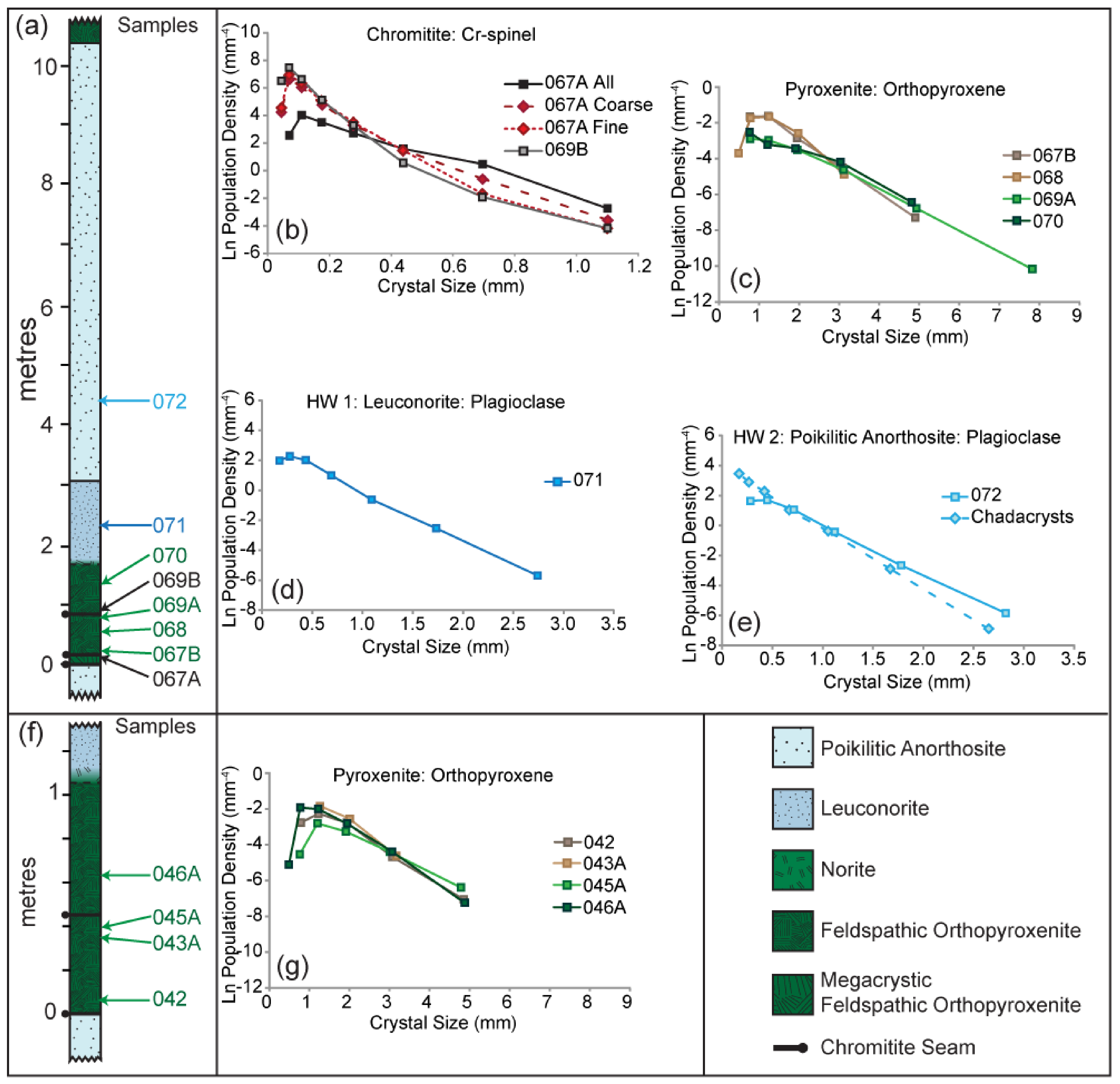


| Sample | Rock | No. of Crystals | Measured Area (mm2) | Population Density | SPO | Lmax (mm) | Y-Intercept (mm−4) | Ci (mm) | Slope (mm−1) | R2 |
|---|---|---|---|---|---|---|---|---|---|---|
| Cr-spinel | ||||||||||
| EJH/15/067A | MR | 2958 | 238.07 | 32.27 | - | 1.14 | 6.62 | 0.10 | −9.82 | 0.973 |
| Base | 232 | 62.05 | 36.14 | - | 1.10 | 4.67 | 0.15 | −6.59 | 0.992 | |
| Top | 2746 | 175.98 | 30.92 | - | 1.02 | 6.99 | 0.09 | −11.01 | 0.968 | |
| EJH/15/069B | MR | 1843 | 87.80 | 27.04 | - | 0.87 | 7.10 | 0.09 | −11.43 | 0.936 |
| Orthopyroxene | ||||||||||
| EJH/15/042 | MR | 241 | 642.75 | 68.13 | 0.15 | 4.49 | 0.36 | 0.73 | −1.37 | 0.992 |
| EJH/15/043A | MR | 418 | 849.09 | 74.42 | 0.14 | 3.54 | 0.22 | 0.67 | −1.49 | 0.978 |
| EJH/15/045A | MR | 198 | 749.78 | 69.04 | 0.26 | 4.87 | −1.41 | 0.98 | −1.02 | 0.993 |
| EJH/15/046A | MR | 400 | 914.51 | 74.22 | 0.24 | 5.04 | 0.47 | 0.74 | −1.34 | 0.983 |
| EJH/15/067B | MR | 232 | 489.19 | 74.17 | 0.17 | 4.50 | 0.21 | 0.65 | −1.53 | 1.000 |
| EJH/15/068 | MR | 497 | 1000.37 | 64.95 | 0.16 | 3.41 | −0.17 | 0.70 | −1.42 | 0.927 |
| EJH/15/069A | MR | 197 | 851.07 | 62.47 | 0.02 | 5.67 | −1.38 | 0.90 | −1.11 | 0.997 |
| EJH/15/070 | MR | 216 | 849.64 | 72.39 | 0.27 | 5.44 | −1.80 | 1.09 | −0.92 | 0.953 |
| Plagioclase | ||||||||||
| EJH/15/071 | HW1 | 909 | 289.14 | 80.32 | 0.30 | 2.92 | 3.23 | 0.30 | −3.29 | 0.997 |
| EJH/15/072 | HW2 | 895 | 327.28 | 89.32 | 0.31 | 2.74 | 3.21 | 0.31 | −3.23 | 0.999 |
| Chadacrysts | 1088 | 251.49 | 70.05 | 0.30 | 2.44 | 3.99 | 0.24 | −4.13 | 0.999 |
© 2018 by the authors. Licensee MDPI, Basel, Switzerland. This article is an open access article distributed under the terms and conditions of the Creative Commons Attribution (CC BY) license (http://creativecommons.org/licenses/by/4.0/).
Share and Cite
Hunt, E.J.; Latypov, R.; Horváth, P. The Merensky Cyclic Unit, Bushveld Complex, South Africa: Reality or Myth? Minerals 2018, 8, 144. https://doi.org/10.3390/min8040144
Hunt EJ, Latypov R, Horváth P. The Merensky Cyclic Unit, Bushveld Complex, South Africa: Reality or Myth? Minerals. 2018; 8(4):144. https://doi.org/10.3390/min8040144
Chicago/Turabian StyleHunt, Emma J., Rais Latypov, and Péter Horváth. 2018. "The Merensky Cyclic Unit, Bushveld Complex, South Africa: Reality or Myth?" Minerals 8, no. 4: 144. https://doi.org/10.3390/min8040144




